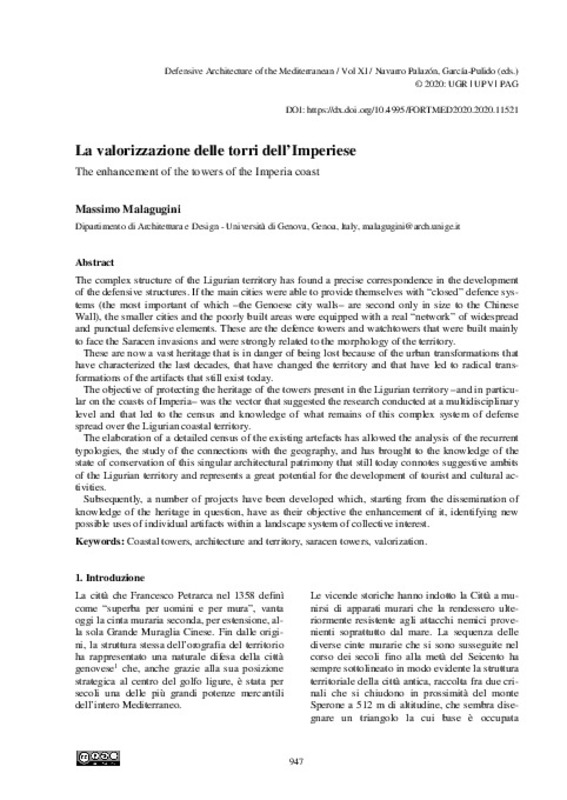JavaScript is disabled for your browser. Some features of this site may not work without it.
Buscar en RiuNet
Listar
Mi cuenta
Estadísticas
Ayuda RiuNet
Admin. UPV
La valorizzazione delle torri dell’Imperiese
Mostrar el registro sencillo del ítem
Ficheros en el ítem
| dc.contributor.author | Malagugini, Massimo
|
es_ES |
| dc.date.accessioned | 2020-07-15T11:12:47Z | |
| dc.date.available | 2020-07-15T11:12:47Z | |
| dc.date.issued | 2020-05-15 | |
| dc.identifier.isbn | 9788490488560 | |
| dc.identifier.uri | http://hdl.handle.net/10251/148050 | |
| dc.description.abstract | [EN] The complex structure of the Ligurian territory has found a precise correspondence in the development of the defensive structures. If the main cities were able to provide themselves with “closed” defence systems (the most important of which –the Genoese city walls– are second only in size to the Chinese Wall), the smaller cities and the poorly built areas were equipped with a real “network” of widespread and punctual defensive elements. These are the defence towers and watchtowers that were built mainly to face the Saracen invasions and were strongly related to the morphology of the territory. These are now a vast heritage that is in danger of being lost because of the urban transformations that have characterized the last decades, that have changed the territory and that have led to radical transformations of the artifacts that still exist today. The objective of protecting the heritage of the towers present in the Ligurian territory –and in particular on the coasts of Imperia– was the vector that suggested the research conducted at a multidisciplinary level and that led to the census and knowledge of what remains of this complex system of defense spread over the Ligurian coastal territory. The elaboration of a detailed census of the existing artefacts has allowed the analysis of the recurrent typologies, the study of the connections with the geography, and has brought to the knowledge of the state of conservation of this singular architectural patrimony that still today connotes suggestive ambits of the Ligurian territory and represents a great potential for the development of tourist and cultural activities. Subsequently, a number of projects have been developed which, starting from the dissemination of knowledge of the heritage in question, have as their objective the enhancement of it, identifying new possible uses of individual artifacts within a landscape system of collective interest. | es_ES |
| dc.language | Italiano | es_ES |
| dc.publisher | Editorial Universitat Politècnica de València | es_ES |
| dc.rights | Reconocimiento - No comercial - Sin obra derivada (by-nc-nd) | es_ES |
| dc.subject | Fortifications | es_ES |
| dc.subject | Mediterranean | es_ES |
| dc.subject | Modern age | es_ES |
| dc.subject | Built Heritage | es_ES |
| dc.subject | Coastal towers | es_ES |
| dc.subject | Architecture and territory | es_ES |
| dc.subject | Saracen towers | es_ES |
| dc.subject | Valorization | es_ES |
| dc.title | La valorizzazione delle torri dell’Imperiese | es_ES |
| dc.title.alternative | The enhancement of the towers of the Imperia coast | es_ES |
| dc.type | Capítulo de libro | es_ES |
| dc.type | Comunicación en congreso | es_ES |
| dc.identifier.doi | 10.4995/FORTMED2020.2020.11521 | |
| dc.rights.accessRights | Abierto | es_ES |
| dc.description.bibliographicCitation | Malagugini, M. (2020). La valorizzazione delle torri dell’Imperiese. Editorial Universitat Politècnica de València. 947-954. https://doi.org/10.4995/FORTMED2020.2020.11521 | es_ES |
| dc.description.accrualMethod | OCS | es_ES |
| dc.relation.conferencename | FORTMED2020 - Defensive Architecture of the Mediterranean | es_ES |
| dc.relation.conferencedate | Octubre 01-03,2020 | es_ES |
| dc.relation.conferenceplace | Granada, Spain | es_ES |
| dc.relation.publisherversion | http://ocs.editorial.upv.es/index.php/FORTMED/FORTMED2020/paper/view/11521 | es_ES |
| dc.description.upvformatpinicio | 947 | es_ES |
| dc.description.upvformatpfin | 954 | es_ES |
| dc.type.version | info:eu-repo/semantics/publishedVersion | es_ES |
| dc.relation.pasarela | OCS\11521 | es_ES |








